Dear Barbara,
From Odessa’s airport to the city, all I see is a meager sun and scattered, bulimic clouds ready to swallow the light. And yet, the first day of spring seems to start right here, in Odessa, probably the most legendary port of Ukraine. This is not a typical Hero City like, for example, Brest. Odessa suffered during World War II, but it also suffered earlier. It seems that cities like Odessa flourished in the 19th century only to be destroyed in the 20th.
I can smell the sea everywhere -or is it the early morning rain that washed Odessa’s worries away? Then, I have an odd thought: maybe that’s not the sea nor the rain. Perhaps it’s blood; its smell remains in the air for a long time. It’s the blood of 1941, spilled by the German allies, but it’s also the blood of 1905 at the Potemkin Stairs.
I know a few things about its past but nothing about Odessa’s present. The famous city at the Black Sea actually got its name by a misunderstanding. The ancient Greek city of Odessos (Οδησσός) was supposedly here. But that’s not valid, Odessos was, in fact, where Varna is, in Bulgaria. One can hold responsible Catherine the Great and her Greek Plan of the 1780s for Odessa’s name. Through the Greek Plan, the Empress of Russia attempted to solve the Eastern Question, which referred to the Ottoman Empire’s partition. All the new cities got Greek names -and that’s also how Odessa was born in 1794.
Smokers and giraffes in Odessa
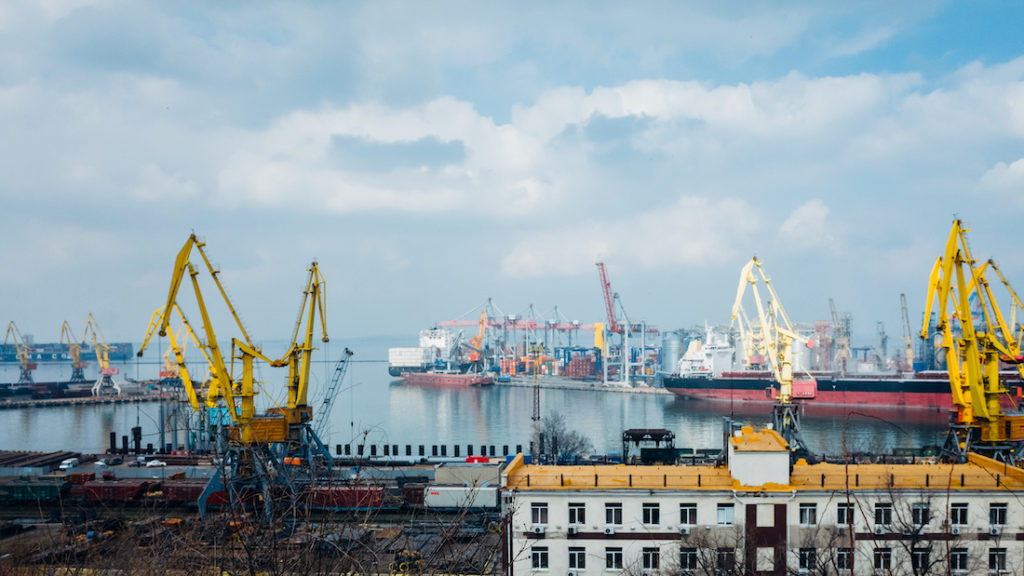
I hear the metallic noise coming from the port, and all these yellow cranes sitting in a row remind me of tired giraffes taking a break. I see the clouds moving towards the Black Sea under the constant noise of constructions. And then, I hear steps behind me. A man is approaching me. I’m standing in an opening of the Sevchenco park, and I listen to his random questions in broken English: Where do you come from? Where do you stay in Odessa? What are you doing here? He doesn’t seem to have any talent in conversation, and a minute later, he asks me for a cigarette. It’s a short chat without verbs -sudden moves of the hands substitute them. “Every day, here. Same time. Now, home. Tomorrow” -he points his finger at me- “again cigarette.”
Odessa is a blurry pearl
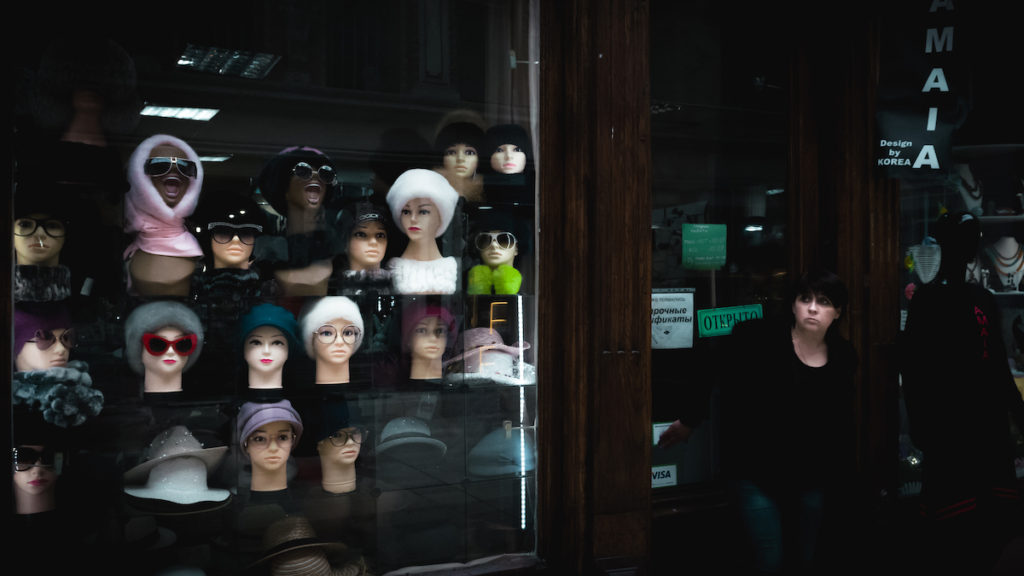
An hour later, I am starring at the buildings of Odessa: elegant architecture in disdain. This fishing-village of the 18th century seems unable to handle the vision of Richelieu. The urban planning is marvelous, though, truly welcoming for future cities. In the very middle of Odessa, among the glorious past and a dubious future, I wonder where the disarray stop and where the reconstruction starts. Anthropomorphic art nouveau buildings, classic Art Decos, neoclassical, all of them slipping into oblivion and decay. The facades have frayed, the balconies have been removed, dispersed wires are hanging from the roofs.
I try to follow the bus routes — old vehicles carrying tired faces. Whenever I see a bus, I try to track it on foot. They move slowly, and their tailpipes smoke like small factories. The women of Odessa embark and disembark like goddesses in exile. They are beautiful beyond words, but they wear clothes that they don’t really accent them. They enter the bus for a few stops, and they avoid eye contact. And when they disembark, they look a tad paler. Odessa’s architecture seems to affect the faces. The city is a blurry pearl, and so are the women of Odessa.
The courtyards of Odessa
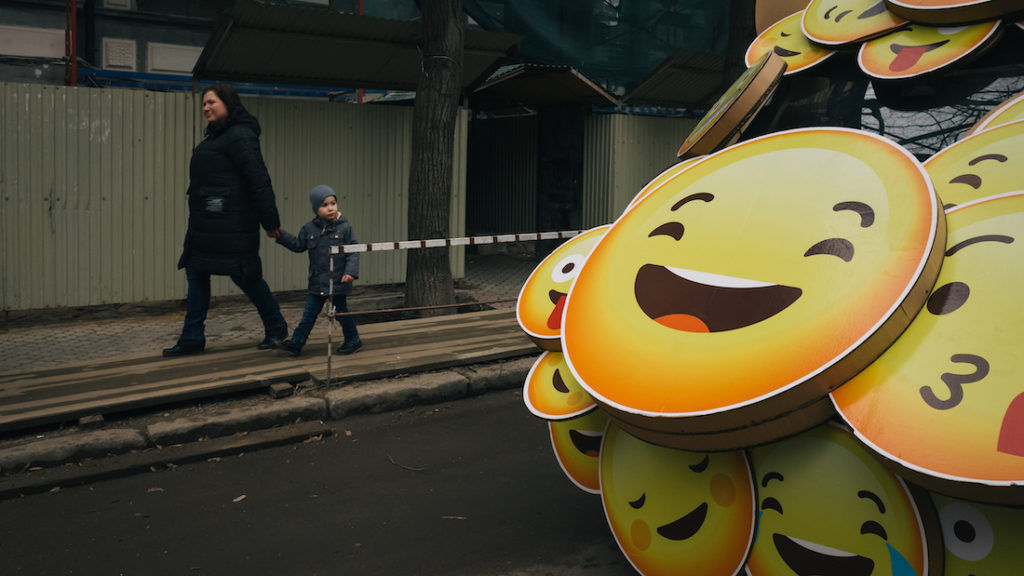
The inner courtyards remind me of small cities within the city. Whenever I see an open front door, I feel the urge to enter. I want to see how life unfolds behind the rundown facades. In most of them, I see old cars, vehicles of former times that nowadays carry more memories than people. Pulleys connect the opposing windows, and the neighbors are hanging wet clothes on them. Flowerpots, self-made storage rooms, and lamps with yellow lights. The gutters follow bizarre routes, but the tiny flowerbeds are waiting impatiently for water. You can’t drink the tap water in Odessa, but the plants seem to enjoy it.
I can only imagine a simple life, sealed by the fragrance of the cheap detergents used for the bed linen, that today dry under an unexpected sun.
That yellow substance at Privoz market
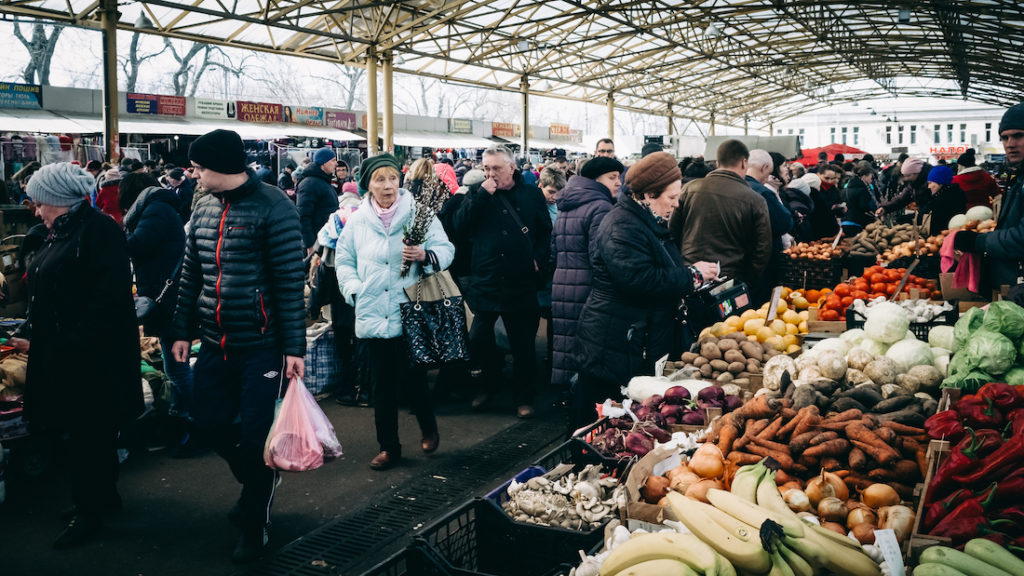
The next morning I am visiting the Pryvoz market, an endless bazaar, where one could buy everything: from groceries to shoes, from smartphones to talismans. The dedication to these objects is almost religious, you can cross the whole bazaar without anyone paying attention to your whereabouts. Or at least that’s what I think.
An older woman comes towards me. She moves slowly; one could even say doubtfully. She tries to sell me something, but I have no clue what it is. It seems to be some sort of pharmaceutics, its color is deep yellow. Honestly, I have no idea if you must cook it, swallow it, or apply it on your skin. I tell her that I don’t need it, but she insists. I nod to some stranger pretending to know him, but the old lady doesn’t buy it. She probably spent her whole life in and around the Privoz Market, and she knows all the tricks.
I keep walking at Privoz Market, taking loads of photos. Half an hour later, I am ready to leave the market, but she is still following me. She points that bottle with the yellow substance towards me and then says something in Ukrainian. The bottle shines brightly under the sun like the golden dome of a church.
At Derybasivska Street
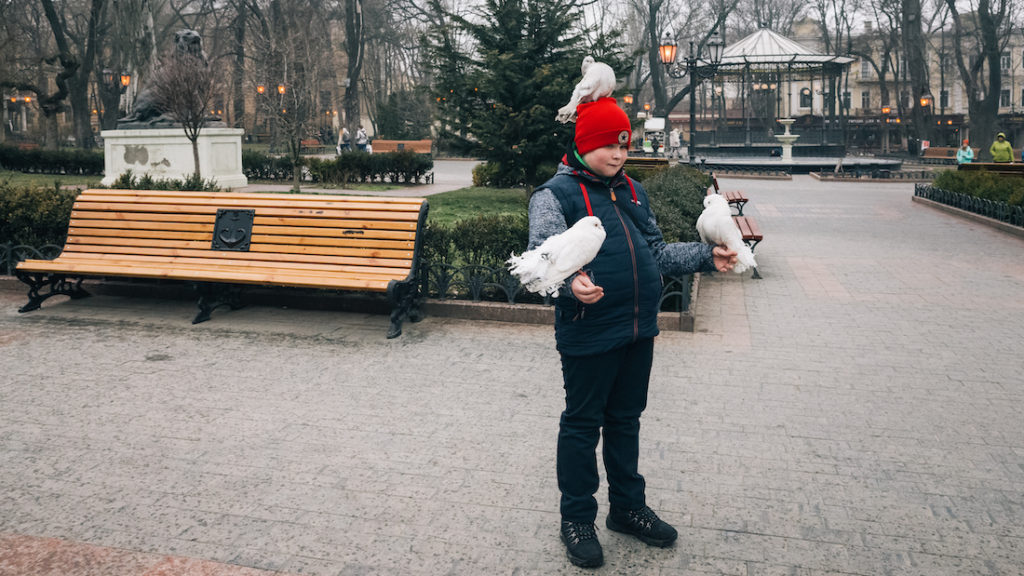
Stray dogs run around the streets, blinded by the light. Derybasivska Street is colorful but not that crowded. It is probably the most well-preserved street of Odessa and therefore surrenders slowly to mass tourism. Next to the fountain, a kid holds pigeons in his hands. He is a young artist of sorts, seeking the attention of the passerby. He places a pigeon in his head and holds another two in his chubby hands. All around the fountain, the benches are packed with people. Whatever is left from the urban version of Odessa seems to be summarized in this park with the well-dressed people.
The Potemkin Stairs in Odessa
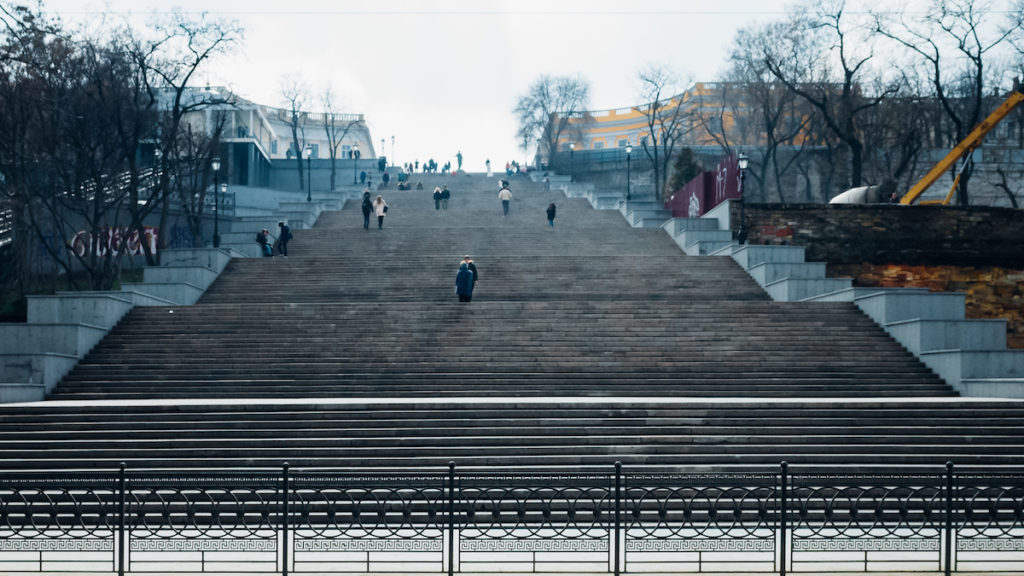
The wind is always strong in Odesa, especially in the streets that drive straight to the Black sea. There are hundreds -or even thousands- cafe kiosks all around Odessa, a typical Eastern Europe motif. You can buy good coffee for a couple of cents, exactly like in Kyiv. But in Odessa, I continuously hear spoons falling on the pavements. On the trunks of tiny cars, the inventive locals attach canopies, and they sell coffee. Each driver is also a waiter, and every time a passerby stops outside of the vehicle, the driver/waiter is waiting for the client’s order. It’s a short break for everyone, and the coffee is tasty: they serve it in paper cups and costs less than forty cents.
That day I buy coffee every two hours, and I walk all along the coastline until I end up at the Potemkin Stairs. It is the ultimate landmark of the city, those 192 stairs have been painted by blood: the sailors of the Potemkin Battleship revolted in 1905 against the awful conditions on board, calling the people of Odessa to also revolt against the Czar. The people of Odessa stood by the sailors’ side, but the revolution was suppressed, and the people were massacred on those very Stairs. I am thinking of the Eisenstein movie, Battleship Potemkin, as I climb the Potemkin Stairs. Then, from the top of the Potemkin Stairs, I see Richelieu’s statue overlooking the sea. He has his back turned to the city that he envisioned: he seems to renounce Odessa.
A day at the Lanzheron beach
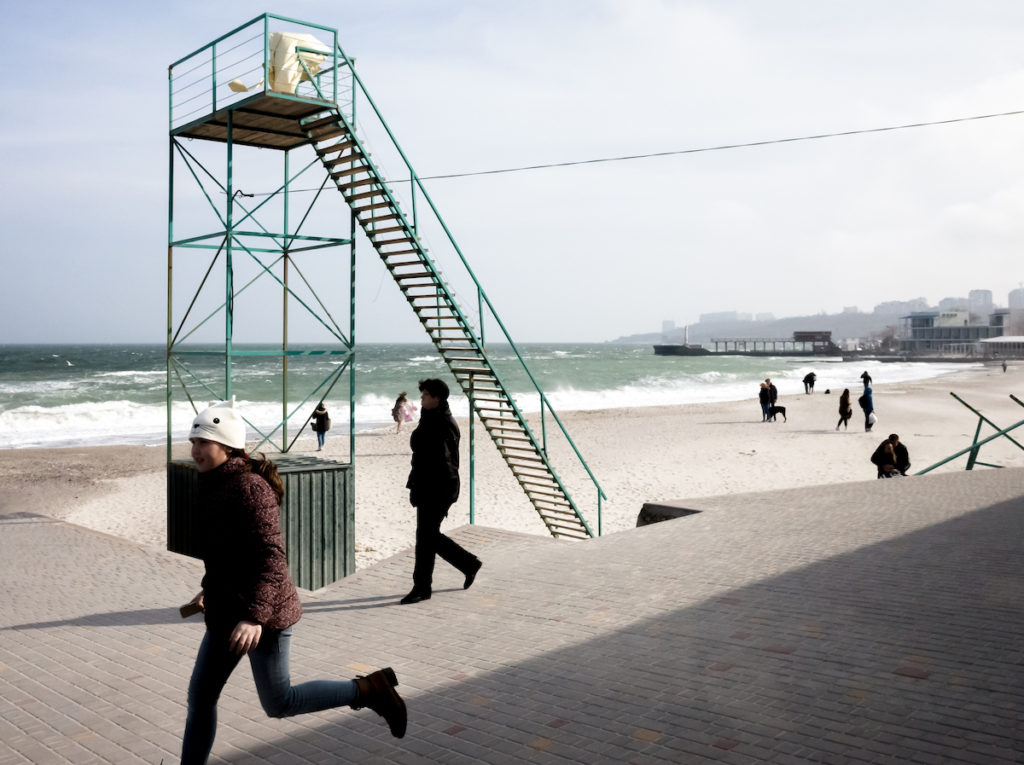
One of the following days, I arrive at the windswept beach of Lanzheron. Ukrainian women with porcelain calves cross their hands beneath their chests. All they do is staring at the chess-players from some distance. Right here, on those tables upon the sand, the expatriates exchange stories of exile and memories from their lost kingdoms. There’s only one word to describe those kingdoms, though: youth. Against the wide Black sea, which is governed by oblivion and only stories keep her awake, these men wearing scarves throw their soldiers in battles on the chessboard.
A young woman walks by: she has survived adolescence and holds colorful balloons. Nobody knows why she is holding these balloons, though. But she walks close to the waves and looks happy. This woman looks like a passing comet that has come all the way to Odessa to celebrate freedom. A bishop crosses the chessboard diagonally, and then the woman, as if she feels an imminent danger, starts to run incessantly across the beach. This might not be an act of rebellion, but then again, who can ignore this moment of free will?
Pasta with fish
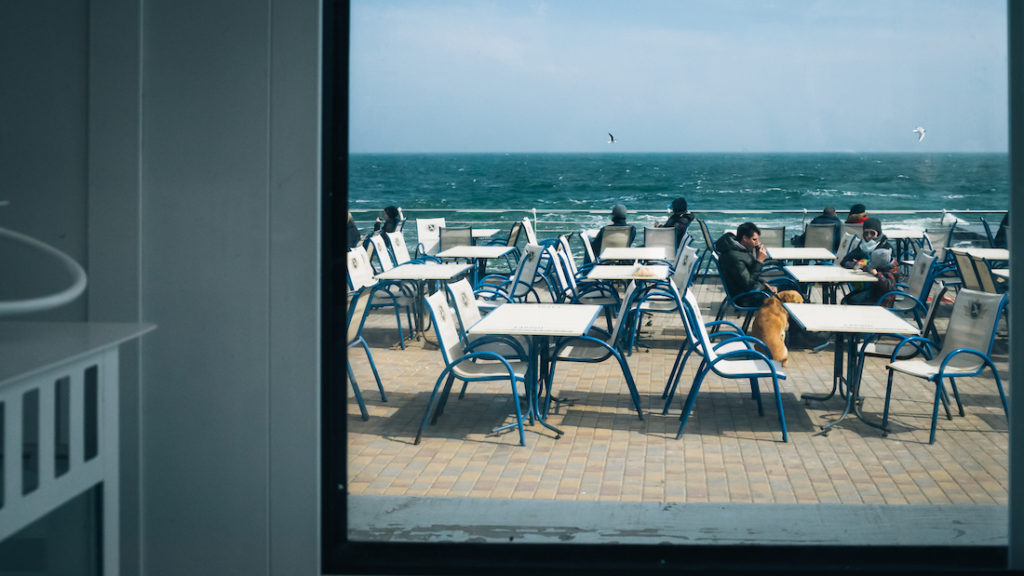
A few meters away, I see a restaurant. It is white and made of wood, and it looks like some sort of summer house for the high society, which always thinks of itself as impeccable. The women’s décolletages are always deep here. That’s not an invitation to aspiring fiances, though. On the contrary, they are there with their husbands, and all they want to achieve is to show off their expensive necklaces. Next to them, the husbands present their fresh skins. No one has wrinkles here. This restaurant is an ode to the overflow of income as well as to a healthy lifestyle.
Pasta with fish and expensive wine, of course. You just have to press a button on the table, and then a dedicated waiter arrives within seconds. The waiters are always young, men and women with bodies under gym-construction. They stand devoutly beside the table, but they look straight in the eyes. The men at the tables exchange jokes with the waiters; cruel snobbism is flowing in the air. But humor is a case between men here; the women at the tables participate just by smiling. The men cross their legs, and as the pants raise a few centimeters to the ankle, one can see socks in the color of the sea.
The Dolphinarium of Odessa and the future
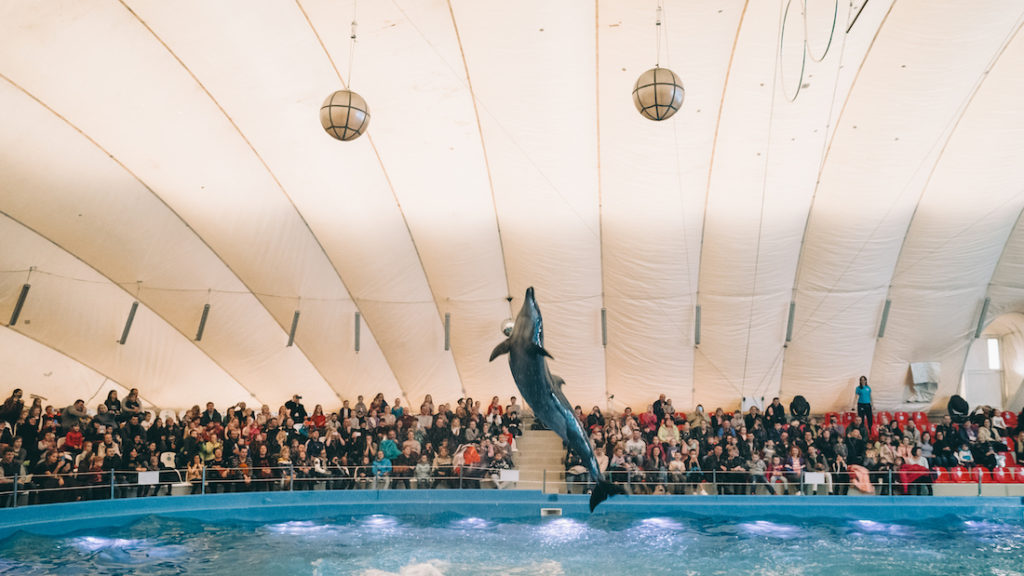
Out of the window and straight at the beach, a happy turmoil takes place. The show at the Dolphinarium of Odessa has just finished, and loads of kids start to run all around the chessboards. The kids don’t pay attention to the battles, though; it’s too early for wars for them. They have just seen the dolphins executing impressive acts and are now full of joy, ready to play until sundown. That’s the privilege of early youth, especially when one can enjoy it in front of the sea.
Soon, I leave the restaurant behind, and I take my place among the crowd. After a long winter, I can’t believe that the weather is so pleasant in Odessa. The street vendors have opened their coffers, the kids play football, the tourists stroll along the coast while the locals eat ice-creams. I feel like being in the middle of a popular feast, in which neither I participate nor belong. But I also stand there, and I’m just observing it like a feast of Italian neorealism. The crowd appears out of the blue and moves in self-referential manners. There are voices and noises all around me.
I’m standing next to the ladder of the lifeguard, and I’m starring at a couple. They are rather old, and they seem like pensioners married for more than fifty years. They cover their foreheads with their left hands and stare, like two bizarre augurs, at the Black Sea. All the lust for the future is encapsulated in those two lonely figures. Life, as I dream it, exists only in front of the sea. One day, I promise to write a poem about them.
Love always,
George
In Odessa, I stayed at the wonderful Frapolli 21 Hotel. Book a room at Frapolli 21 here or check your other options in the map below.
More about Ukraine: A travelogue about Kyiv, Ukraine International Airlines Review
Pin it for later
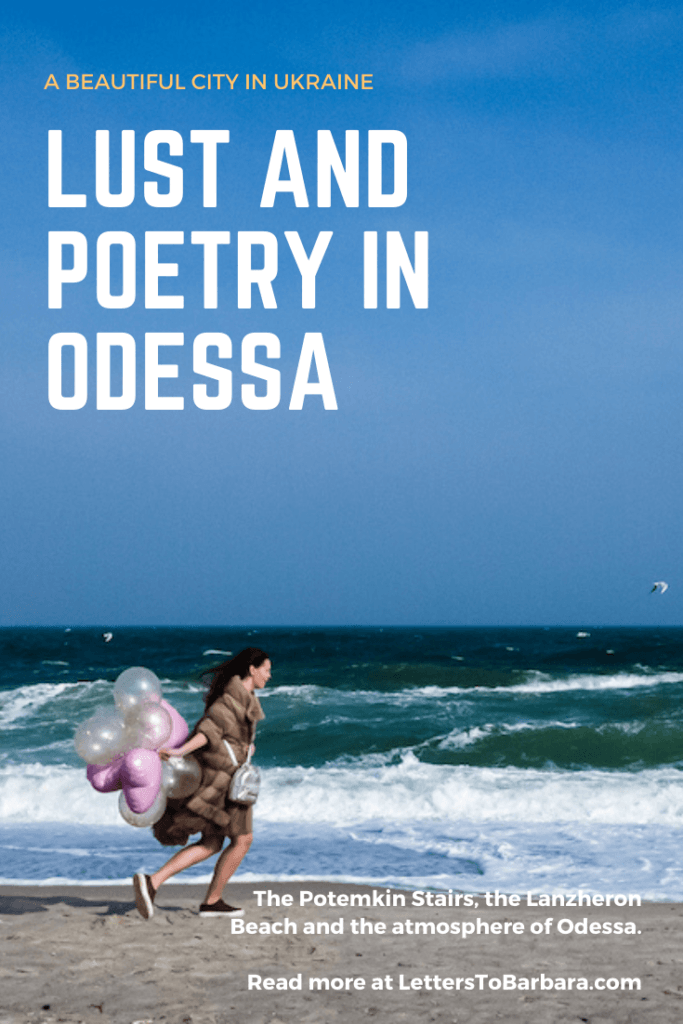
Please share, tweet, and pin if you enjoyed reading Lust and Poetry in Odessa. Your support keeps this website running and all the info up-to-date. 🙂
Last Updated on November 12, 2020 by George Pavlopoulos

